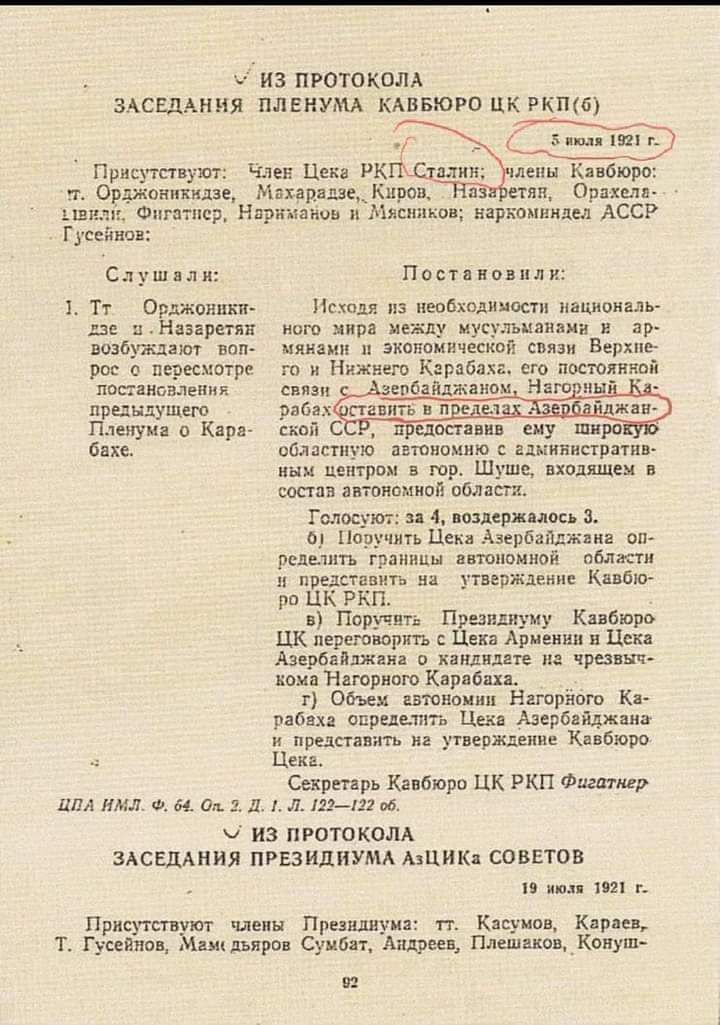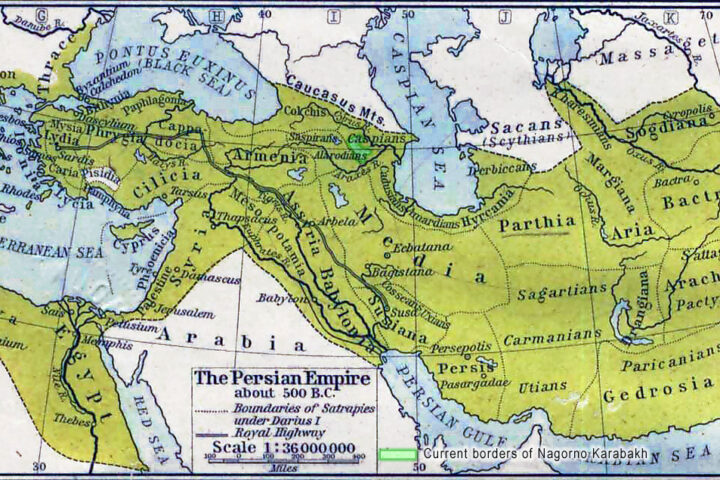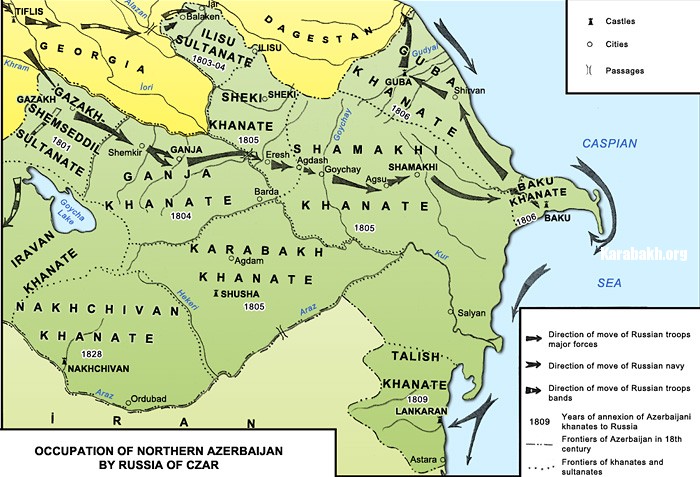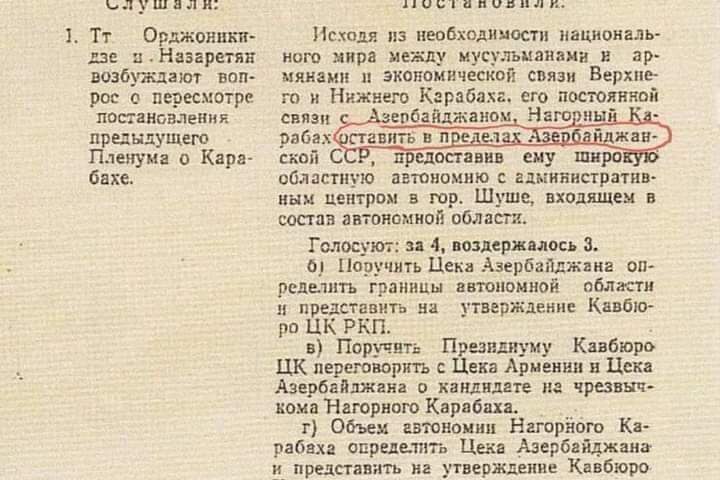Mir Jafar Bagirov’s Memo (1923)
The last, fifth, point of the decree of the CEC of Azerbaijan on setting up the NKAR suggested that a mixed commission of representatives of Nagorno-Karabakh, Lower Karabakh, Kurdistan, and the central government of the A.S.S.R. should be set up to draft a Statute for the region, transfer the administrative units to the autonomous region, and draw its borders. The job should be completed before 15 August.125
On 14 July, 1923, the Presidium of the C.C. Az.C.P. (B.) discussed the need to draft a Statute to provide legal substantiation of the creation of the NKAR; it set up a commission consisting of A. Karakozov, Ch. Ildrym, M. Khanbudagov, M. Chalyan, and S. Manutsyan with D. Buniatzade as its chairman (because A. Karaev could not take part in the commission).
The commission had to work hard to be able to present the draft Statute in the shortest time possible to the Presidium of the C.C. Az.C.P. (B.) for approval.126
On 23 July, the Presidium discussed the issue once more and made several insignificant amendments to the draft Statute. The Committee for Nagorno-Karabakh was liquidated and its property was transferred to the Revolutionary Committee of the autonomous region.127
Late in July, the Council of People’s Commissars of Azerbaijan issued 8 thousand chervontsy (10-ruble banknotes in use in the Soviet Union in 1922-1947), 5 thousand poods (a pood—Russian measure of weight = 16.38 kg) of kerosene, building materials, and 10 thousand arshins (an arshin—Russian unit of length = 28 inches) of cloth totaling 15 thousand gold rubles to the NKAR.128
Late in July 1923, the Statute commission gathered for a more extensive sitting to discuss the Statute based on the 1923 Statute of the gubernia executive committees.
An autonomous region was set up for the local Armenians but it was decided to include the numerous Turkic villages of Karabakh in it. The majority (with three members abstaining) voted to include Shusha and the Khonashen village in Lower Karabakh.
Karakozov insisted that both the city and the village should remain within Upper Karabakh; his opinion, supported by the Commission chairman, outweighed the votes of six highly placed Azeri officials. The meeting agreed on the form of administration and the administrative division of Lower Karabakh and Kurdistan.129
A year later, on 5 June, 1924, the commission which delimitated the Agdam Uezd and the NKAR decided that the Khonashen lands and, in particular, the village of Kuropatkino should remain within the NKAR, according to the decision of the CEC of Azerbaijan of 6 August 1923; in 1924 the Avshars were allowed to bring in the harvest from their land.130
On 20 August, the Presidium of the C.C. Az.C.P. (B.) and, on 5 September, the C.C. Secretariat dispatched E. Khanbudagov, I. Dovlatov, and M.J. Bagirov to Karabakh to study the situation, talk to the people, and sort out the conflict between the Muslim village of Kolany and the Armenian settlement of Sarov.
On 8 October, the Presidium discussed the results and ruled that:
1. The People’s Commissariat for Land should be instructed to supply Nagorno-Karabakh with free timber.
2. The Council of People’s Deputies should be instructed to discuss the possibility of increasing the grain quota for Nagorno-Karabakh in the form of debt; speed up financing of the electric power project in Khankendi; and extend urgent help to the starving population of Nagorno-Karabakh.
3. Karakozov and the People’s Commissariat for Land should be instructed to look into the use of land.
4. The People’s Commissariat for Health should be instructed to open a medical post in Khankendi (not at the expense of the Agdam and Terter medical posts).
5. The Karabakh Regional Committee and the Regional Revolutionary Committee should be instructed to study the borders of the Kurdistan Uezd in the vicinity of Kaladarasi to include the Kurdish villages in the Kurdistan Uezd.131
It should be said that information relating to Point Five of the decision could be found in the extensive memo supplied by Bagirov, which summed up the results of his mission and said, in particular, that the population of Shusha (numbering 10 thousand) wanted to join the Kurdistan Uezd.
Bagirov believed that Shusha (with its Muslim population) should be united with the Kurdistan Uezd to become its center and that it was wrong to make the city part of Nagorno-Karabakh. In his report he noted: “There are several Muslim villages (Khalfali, Zaristy, Musulmanlar, and several others with a total population of up to 8 thousand) in the vicinity of Khan-Kendi, Shusha, and Abdalar. It is much easier to manage them from Abdalar than from Khan-Kendi because there are small Kara-Darasi settlements with about 1,150 Armenians along with the Muslim villages. For some reason, however, the entire area was joined to Khan-Kendi.”132
Bagirov (one of those entrusted with sorting out the conflict between Kolany and Sarov) wrote that, during the confusion in the Jevanshir Uezd, the Muslims of Kolany captured the Armenian village of Sarov on instructions from the Center. Later they abandoned the captured territory and returned to their villages. The Sarov Armenians, wrote Bagirov, should have pulled out of the land captured from the Kolany Muslims. He went on to say that “because of the criminal attitude of some of our officials to the matter, instead of retreating to their village, some of the Sarov people remained on the Kolany’s land, while others moved to Sarov. This means that 5 thousand Kolany people have nowhere to go. I should say that the Kolany people are the most troublesome in Karabakh; so far they remain silent because they expect a fair decision from the government.”133
Bagirov also touched upon more serious matters by saying: “From time immemorial, Muslims from the village of Khojali, the residents of Muganli, etc. have been coexisting with Armenians along the road between Agdam and Karyagino in the Khanabad area. During the massacre, these villages, both Armenian and Muslim, were plundered, while the villagers scattered. Recently, they returned only to discover than an ugly mistake had been made. Under the new delimitation of land, a Muslim cemetery was transferred to the Armenians; today Armenians from faraway regions who have nothing to do with these places work on the land of Muslims who are still waiting for a final settlement.”134
Nariman Narimanov: “Under Mirzoyan’s Strong Pressure Nagorno-Karabakh was Made an Autonomous Region”
The decision of the CEC of Azerbaijan of 7 July did not alleviate the mass discontent. In November 1924, the final draft of the Statute for the Nagorno-Karabakh Autonomous Region, a product of prolonged discussions edited by Bagirov, Aliev, and Karakozov, was transferred to the 4th session of the plenary session of CEC of Azerbaijan (second convocation).
CEC Secretary M. Khanbudagov summed up the draft; it was decided to offer it to the CEC Presidium for further consideration.
The same month, the Statute was published in the press. Article One confirmed that “the Nagorno-Karabakh Autonomous Region is part of the Azerbaijan S.S.R.;” Article Two said that “clerical work shall be conducted in the native language;” and Article Three ruled that “the Nagorno-Karabakh Autonomous Region shall be proportionally represented in the republican structures of Azerbaijan.”135
The Statute ruled that government and public institutions and organizations should use Armenian when dealing with the Armenians and the Turkic (Azeri) language when dealing with the Turkic minority.136 The Azeris found themselves a national minority in their own country.
In July 1923, 169 villages of the Shusha, Jevanshir, and Gubadli uezds were included in the NKAR at the commission’s suggestion; the text published on 26 November, 1924 enumerated 198 settlements.137
The autonomy received 115 villages of 16 village communities in the Shusha Uezd, along with the city and Khankendi; 52 villages of 6 village communities of the Jevanshir Uezd; 30 villages of 3 village communities of the Karyagino Uezd; and the Galaderesi village community of the Gubadli Uezd.138
In 1923, the NKAR covered a territory of 4,160.5 sq. km; ten years later it was 4,431.7 sq. km.139
At no time were the Armenians satisfied with the concessions of the Azerbaijan S.S.R.
Karakozov wrote to Kirov that the Collegium of the People’s Commissariat for Justice had established a Supreme Court for Nakhchivan, while there was no similar court in Nagorno-Karabakh despite a corresponding decree of the CEC of Azerbaijan, and described this omission as politically untenable. On the other hand, according to its Constitution, Karabakh as an autonomous region did not differ from Nakhchivan, which meant that the decisions relating to it should equally apply to Karabakh.140
On 1 August, 1923, the smaller Presidium of the CEC of Azerbaijan recommended that the Presidium treat Pirijan as the center of the Kurdistan Uezd and the city of Agdam as the center of the Agdam Uezd, while the center of the Jebrail Uezd should be moved from Karyagino to Jebrail.141
On 6 August, the Presidium of the CEC of Azerbaijan approved the administrative-territorial division of the Agdam Uezd with its center in Agdam, the Jebrail Uezd with its center in Jebrail, and the Kurdistan Uezd with its center in Pirijan.142
On 18 September, 1923, the Regional Party Committee of Karabakh met under the chairmanship of Manutsyan (Ter-Zakharov served as the secretary) to discuss renaming the city of Khankendi. After a short discussion it was decided “to change the name of the city of Khankendi to Stepanakert in commemoration of Stepan Shahumyan and 26 commissars.”143The same day, the CEC of Azerbaijan approved the decision.
The leaders of Azerbaijan tried to present the name as “Stepan kend,” and this is how it was written for some time in official documents, but the Armenians finally insisted on the official form of “Stepanakert.”144
The leaders of Azerbaijan launched an extensive propaganda campaign in favor of the Karabakh autonomy and did not spare any efforts explaining the developments to the local people.
This is how the struggle over the territorial affiliation of Nagorno-Karabakh which began in the first years of Soviet power in the Transcaucasus ended. In May 1924, at the 6th Congress of the Communist Party of Azerbaijan, Sergey Kirov, who headed Azerbaijan, said the following about the autonomy of Nagorno-Karabakh: “Settlement, even if not final at least considerable, of the so-called Karabakh issue can be described as the most important and the most impressive achievement in this field. This question belongs to those relating to the Transcaucasian Federation.”145
On 27 May, 1924, Nariman Narimanov wrote the following to Stalin: “Under Mirzoyan’s strong pressure, Nagorno-Karabakh was made an autonomous region. I was not able to accomplish this, not because I was against the autonomy, but because the Armenian peasants themselves did not want this. Meanwhile, Mirzoyan, assisted by the Dashnak teachers, tilled the soil and pushed the decision through the Transcaucasian Territorial Committee.”146
He knew that the trouble for Azerbaijan did not stop there; he predicted that the autonomy of Nagorno-Karabakh was the beginning of a future tragedy.







